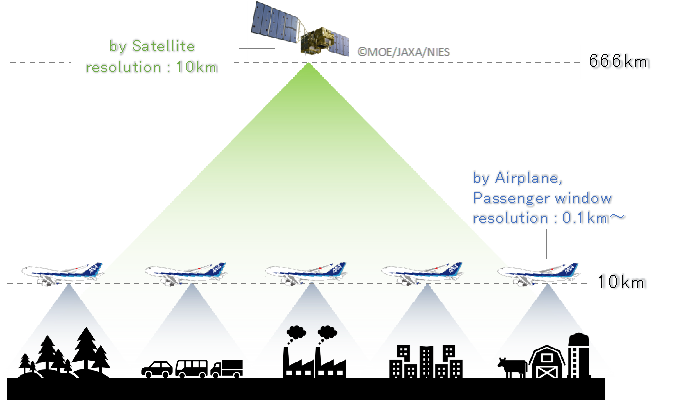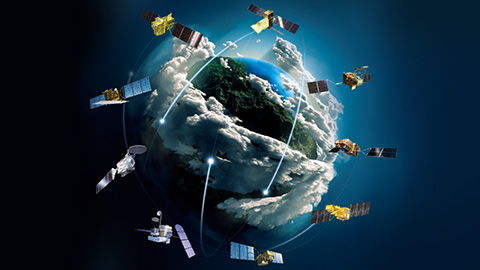News
2024.10.03 Thu
Tour of “GOBLEU Project” by IPCC Seventh Assessment Report Bureau Members
The Intergovernmental Panel on Climate Change (IPCC)*1 Seventh Assessment Report Bureau*2 members visited ANA’s maintenance facility located at Haneda Airport for a tour of the “GOBLEU Project*3” implemented by Japan Aerospace Exploration Agency (JAXA) and ANA HOLDINGS INC. (ANAHD).
The GOBLEU project is to observe and analyze greenhouse gases with observation instruments, applying the technologies of JAXA’s Greenhouse gases Observing SATellite “IBUKI” (GOSAT)*4, onboard passenger aircraft operated by ANA between Tokyo Haneda Airport and Fukuoka Airport, aiming to evaluate greenhouse gas emissions in urban areas by source, such as transportation and industry.*5
Dr. Ladislaus Chang’a, Vice-Chair and three Co-Chairs of each Working Group from the IPCC Seventh Assessment Report Bureau, which provides a comprehensive scientific and technical assessment of climate change, toured a real passenger aircraft equipped with observation instruments at ANA’s maintenance facility.
The members expressed their expectation that the observation data from the aircraft will make it possible to evaluate and visualize the greenhouse gas emissions by source in urban areas, and will be useful in providing information to evaluate the reduce of the emissions. They also expressed their expectation to scale up and integrate this activities to capacity development effort in the future.
Through this project, JAXA and ANAHD aim to contribute to international initiatives to reduce greenhouse gas emissions from space and the sky, and will continue to make efforts to realize a sustainable society.
- ※1
- The Intergovernmental Panel on Climate Change (IPCC) is an intergovernmental entity, established in 1988 by the World Meteorological Organization (WMO) and the United Nations Environment Programme (UNEP), and currently has 195 members from countries and regions. IPCC assessments provide policymakers with the latest scientific knowledge on climate change and provides vital scientific information and technical guidance to the climate change process including the United Nations Framework Convention on Climate Change (UNFCCC) and the governments for use in developing national climate policies.
- ※2
- The IPCC has published a report every five to seven years since its First Assessment Report in 1990, and is currently in its Seventh Assessment cycle, which began in July 2023. The IPCC elects the Bureau for each assessment cycle. The Seventh Assessment Report Bureau consists of 34 members: IPCC Chair (1) and Vice-Chairs (3), Woking Group Co-Chairs (2 each, 6 in total) and Vice-Chairs (22 in total), and Co-Chairs of the Task Force on National Greenhouse Gas Inventories (2).
- ※3
-
Greenhouse gas Observations of Biospheric and Local Emissions from the Upper sky Project
This initiative has been announced in press releases on September 28, 2020.
https://global.jaxa.jp/press/2020/09/20200928-1_e.html
https://www.anahd.co.jp/group/en/pr/202009/20200928.html - ※4
- Greenhouse gases Observing SATellite “IBUKI” (GOSAT)
- ※5
- A technical overview and observation results of this initiative were published in the Carbon Balance and Management No.19 (2024). ”The Greenhouse gas Observations of Biospheric and Local Emissions from the Upper sky (GOBLEU): a mission overview, instrument description, and results from the first flight” (https://doi.org/10.1186/s13021-024-00273-1)
■Purpose and effect of measurements from aircraft
GOSAT, launched in 2009, accurately measures CO2 concentrations from an altitude of 666 km. However, the spatial resolution of a single observation point is not sufficient, with a diameter of about 10 km, making it difficult to evaluate individual emission sources, even though emissions can be estimated for a wide area.
Passenger aircraft, on the other hand, fly at altitudes of 10 km or less, much closer to the Earth’s surface than satellites, and therefore can be expected to provide more detailed data. Combining the characteristics of satellites and passenger aircraft is expected to create new value.

■Major roles of each party
JAXA: Investigation of spectroscopic observation methods using passenger aircraft, Data acquisition by aircraft observation, Analysis and evaluation of observation data, Study of feasibility and possibility of regular operation
ANAHD: Investigation of spectroscopic observation methods using passenger aircraft, Data acquisition by aircraft observation, Study of feasibility and possibility of regular operation
Search by Year
Search by Categories
Tags
-
#Agreement
-
#Application
-
#Award
-
#Climate
-
#DAICHI (ALOS)
-
#DAICHI-2 (ALOS-2)
-
#DAICHI-3 (ALOS-3)
-
#DAICHI-4 (ALOS-4)
-
#Disaster Management
-
#EarthCARE/CPR
-
#Education
-
#GPM/DPR
-
#HIMAWARI
-
#IBUKI (GOSAT)
-
#IBUKI GW (GOSAT-GW)
-
#IBUKI-2 (GOSAT-2)
-
#KIZUNA (WINDS)
-
#SHIKISAI (GCOM-C)
-
#SHIZUKU (GCOM-W)
-
#Tour and Exhibits
-
#TSUBAME (SLATS)
Related Tags
Related News
- News 2025.10.01 Wed
- News 2025.07.08 Tue
- News 2025.06.30 Mon
- News 2025.06.30 Mon
- News 2025.06.30 Mon









